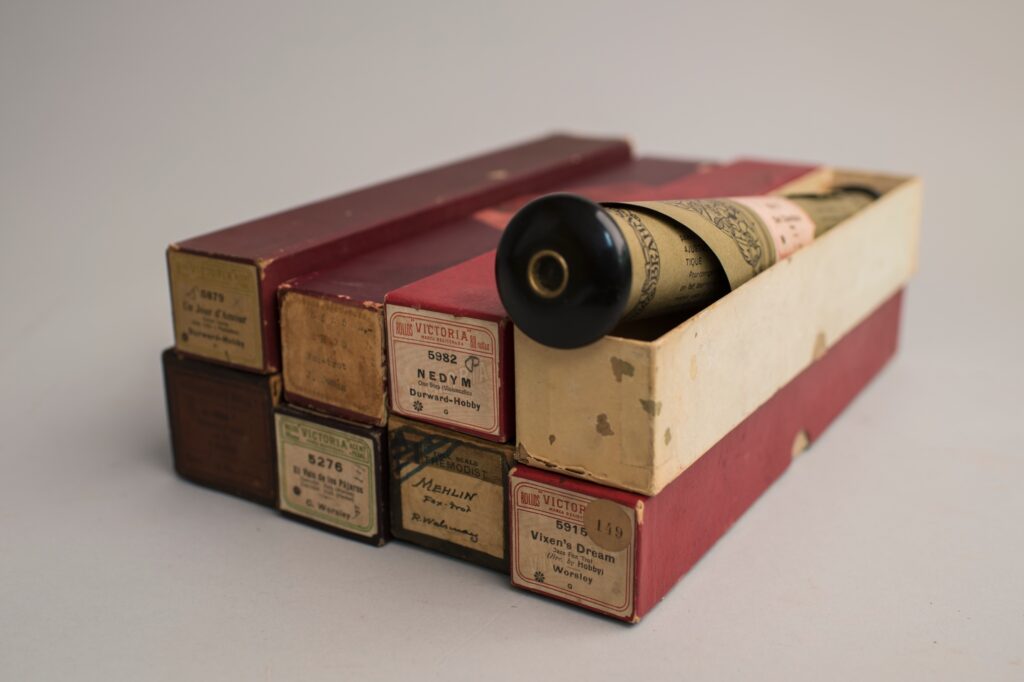
BARCELONA MUSEUM OF MUSIC
COMPOSERS UNDER A PSEUDONYM
THE CASE OF DANCE MUSIC EDITED ON PIANO ROLLS
The pianola (or player piano) was a phenomenon of great importance during the first third of the last century. Just before the emergence of records, which would define the logic of music markets for a large part of the 20th century, perforated paper sheets were one of the first systems for the mass dissemination of music, with a global reach and a hitherto largely unknown but surprisingly large market. In Catalonia, for example, the editor Victoria de la Garriga – pioneer and an undisputed leader in the Iberian Peninsula – managed to produce more than one hundred thousand rolls a year. In Spain there were around 20 specialised companies, while in the City of London alone, there were more than 50 working.
There were different types of piano rolls, some of which were recorded directly from the piano (usually calledhand-played rolls) and others were made by manually transcribing the sheet music onto the master roll, from which copies were made mechanically. The latter, called ‘metronomic’ or arranged rolls, were the most common and owe their name to the fact that they required a performance, of at least the fundamental musical parameters such as tempo and dynamics. This was possible thanks to some controls or levers that were on the instrument, right in front of the keyboard. Some pianolas only had tempo and dynamics control, but others even enabled players to operate the pedals and accentuate certain notes. While the roll was running in front of the pianist, graphic indications printed on the paper acted as a guide for the performance. This interpretative task required a refined technique without which the pianola was an instrument with little or no musicality; therefore, the pianolist’s skill was a determining factor when it came to enjoying a good quality of sound.
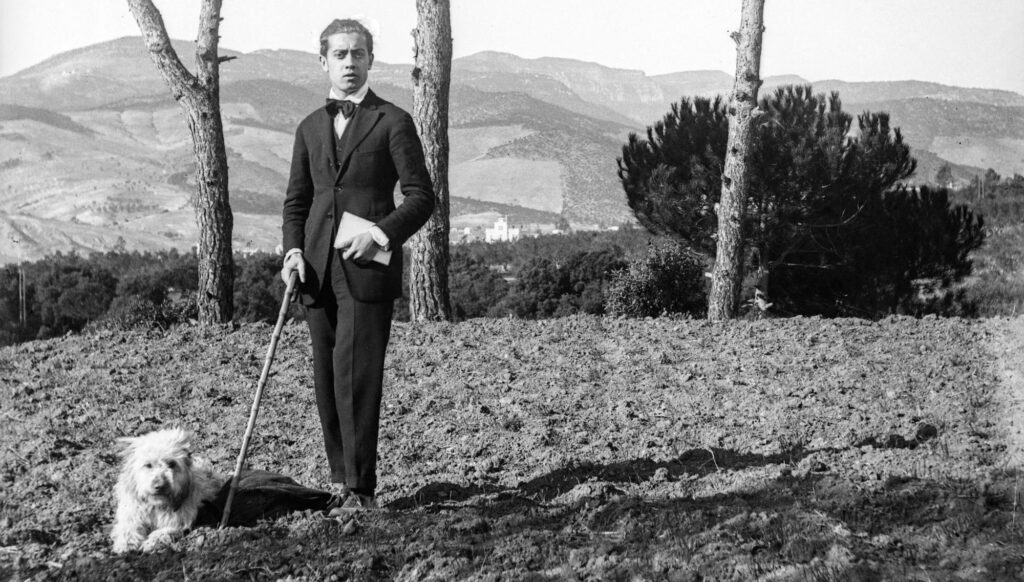
CATALAN COMPOSERS
Works by Frederic Mompou, Manuel Blancafort, Pere Astort i Ribas, Josep Maria Pla i Mateu, Rafael Martínez Valls, Llorenç Torres Nin and Antoni Oller i Guinovart.
The selection of pieces in this collection comes from one of the fundamental genres of the repertoire of this instrument: dance music. The set of compositions also has a special attraction, as they are works signed under pseudonyms written by well-known composers. In many cases, we were unaware until now that they had produced works of this type. They all come from a time when the separation between the supposedly transcendental music of inspiration (and aspiration) and the music considered ‘consumer’ music was practically impossible to ignore. Direct heirs of the Romantic tradition, these composers hid behind pseudonyms for a number of reasons, especially due to a certain inertia framed within the logic of the market at that time, besides an understandable reluctance to include a repertoire of dance and popular music in the respective official catalogues. A reticence that denotes the strong influence that the academic establishment exerted – and still exerts – on the models of western musical thought. Although we know that some of these composers never made any effort to claim authorship of these pieces, the latest epistolary studies confirm that often the composition of this dance music was not only aimed at earning a bit of extra money – as has been insinuated on some occasions – but was approached with a strong conviction and a sincere attraction to this type of music. From foxtrot to ragtime, including marches and waltzes of different natures, all the compositions in this collection have a common denominator: dancing in society, or the ballroom dancing, this social encounter in which music is the indispensable element for unfolding a complex network of human interactions. In Catalonia, there are many private collections of piano rolls that remind us of this picture of dancing in society in the middle-class homes, such as: Mas Roger in Priorat, the palace of the Counts of Bell-lloc in Cornellà, Casa Gaudí in Parc Güell in Barcelona and Casa Navàs in Reus are clear examples of this model of social leisure which, evidently, had a strong appeal in Catalonia. In all these houses, now converted into museums or institutional spaces, there are thousands of piano rolls that a century ago were the fuel for these high society gatherings. A curious fact: out of music of Romanticism, zarzuela (Spanish opera) and dance music, the rolls of the latter are the most worn out, which clearly shows that they were the most used. However, besides this activity reserved for high society, it is important to bear in mind that these rolls were present in cafés, social centres, cinemas and theatres, and that, therefore, the pianola phenomenon was much more mainstream than we might imagine at first glance.
Jordi Roquer i González
Universitat Autònoma de Barcelona
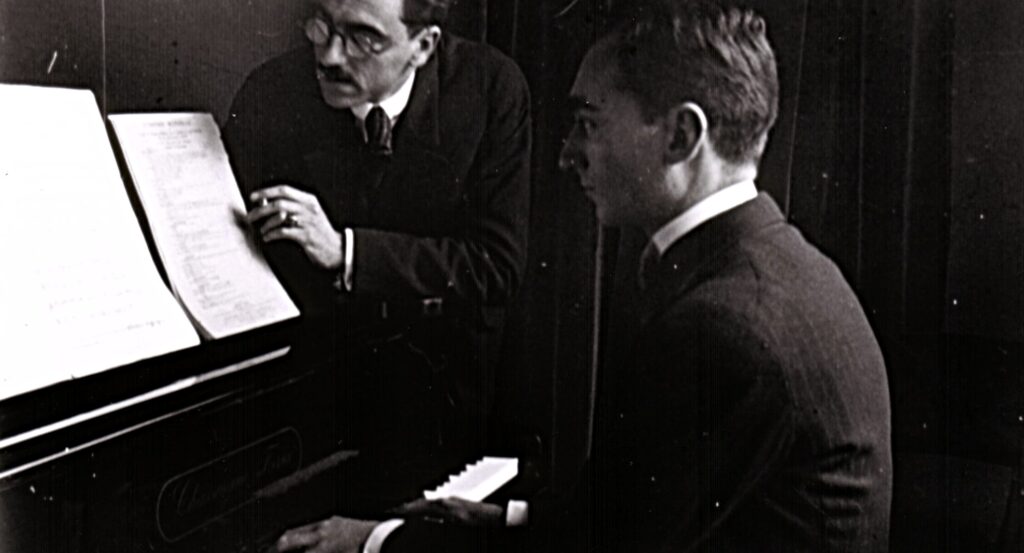
THE PSEUDONYMS
Hobby is the pseudonym under which Frederic Mompou (Barcelona 1893 – 1987) and Manuel Blancafort (la Garriga 1897 – Barcelona 1987) signed more than twenty works of dance music, all published by Rollos Victoria, owned by Blancafort’s father. It was precisely in the piano-roll factory in La Garriga where the young composers often discussed and shared their creative concerns about composing. Reading letters from this period it becomes clear to us that the pianola turned into a real source of inspiration, leading the composers to experiment with the inverse reproduction of passages, a practice that Blancafort would end up applying to symphonic pieces such as The Rape of the Sabine Women. From 1921, when Mompou moved to Paris, the two composers would continue this complicity for a few years, composing melodies and arrangements for foxtrot, shimmy, ragtime and other genres of dance music.
Clifton Worsley is the pseudonym of Pere Astort and Ribas (Barcelona 1872 – 1925). When he was very young, while he was working at the current Casa Beethoven (known then as Can Guàrdia), he came into contact with the sounds of American dance music, probably due to the sailors who used to walk up and down the Rambla to visit the city while the ships were docked at the port of Barcelona. Worsley signed a considerable number of works and he is actually the only Catalan composer of dance music that we find in the catalogues of large American companies, such as Aeolian or Connorized.
X. Poli is the pseudonym of Josep Maria Pla i Mateu (Tarragona, 1889 – Barcelona, 1967), who was the conductor of the Orquestra Clàssica Gracienca. Besides X. Poli, Pla i Mateu adopted at least another two pseudonyms: Franz Wrethel, to sign waltzes and chotís, and Gustavo Duvel, when he composed music for the cuplé singers, Raquel Meller (1888-1962) and Mercè Serós (1900-1970).
R. Walsmay is the name under which we find works by the composer Rafael Martínez Valls (Ontinyent 1895 – Barcelona 1946). The author of Cançó d’amor i de guerra was the artistic director of the Aeolian Hall in Passeig de Gràcia, one of the venues where, apart from conventional concerts, pianola-roll concerts and demonstrations were held.
J. Demon or Mestre Demon, is the artistic name of Llorenç Torres Nin (Menorca 1890 – Barcelona 1964), a Menorcan composer who moved to Barcelona, where he became known as a light music performer at the head of the Demon’s Jazz orchestra.
Under the name of Harry Wilson is Antoni Oller i Guinovart (1895 – 1968), son of the anarchist Baldomero Oller (1859-1936) convicted in the famous Montjuïc trial of 1896, a sentence that could finally be commuted to exile in the United Kingdom. We know very little about the life of Oller and Guinovart, but we do know that he spent his childhood and youth between London and Paris, cities where he probably took his first steps as a musician and composer. Her dance music rolls are edited by Victoria and Edimes from Madrid.
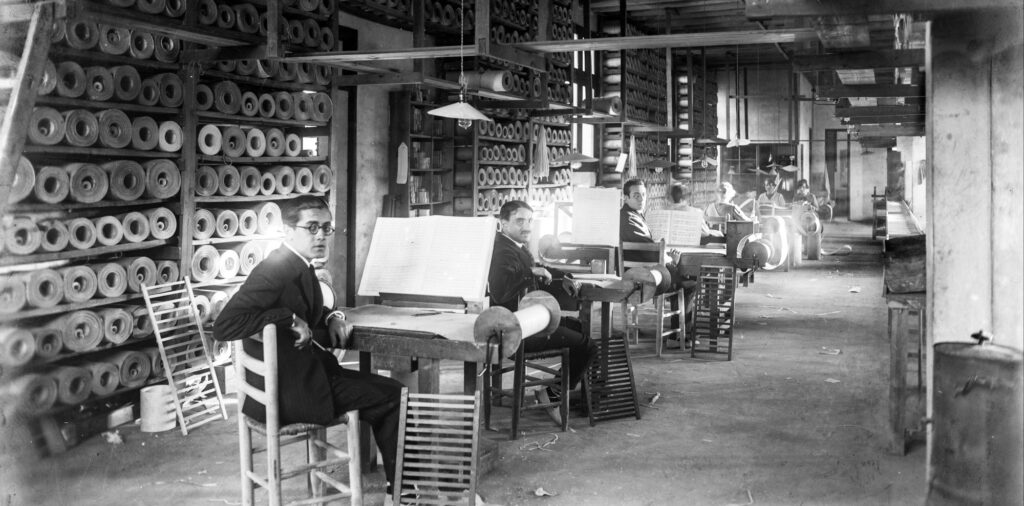
CREDITS
THE PIANOLIST
Rex Lawson (England 1948) is one of the most internationally renowned pianolists. He studied at the University of Nottingham and the Royal College of Music in London and in 1971 he abandoned his traditional music career to specialise as a pianola player. Since then he has recorded a large number of albums with works by Rachmaninoff, Paderewski, Busoni and Stravinsky, among many others. He has performed in numerous concerts all over Europe and North America, which include several highlights, such as his performance in Carnegie Hall in George Antheil’s Mechanical Ballet , the revival of Percy Grainger’s recording of Grieg’s Piano Concerto for the Last Night of the Proms in 1988, and diverse performances of Stravinsky’s pianola works in the Théâtre des Champs-Élysées in Paris.
THE RECORDING
The pieces that make up this selection come from the collections of piano rolls of the Barcelona Music Museum, the Biblioteca de Catalunya (National Library of Catalonia) and Mas Roger (Arxiu Comarcal del Priorat – Archive of the Priorat County) and were recorded in London on the 24 and 25 of January 2018 by Rex Lawson, using a Steck grand Pianola Piano kindly loaned by Denis Hall.
This recording has been possible thanks to the participation of the Barcelona Music Museum, the Biblioteca de Catalunya (National Library of Catalonia) and the Arxiu Comarcal del Priorat (Archive of the Priorat County), and has benefited from the support and sponsorship of the Association for Recorded Sound Collections (ARSC) and the Robert Gerhard Centre for the promotion and diffusion of the Catalan musical heritage.
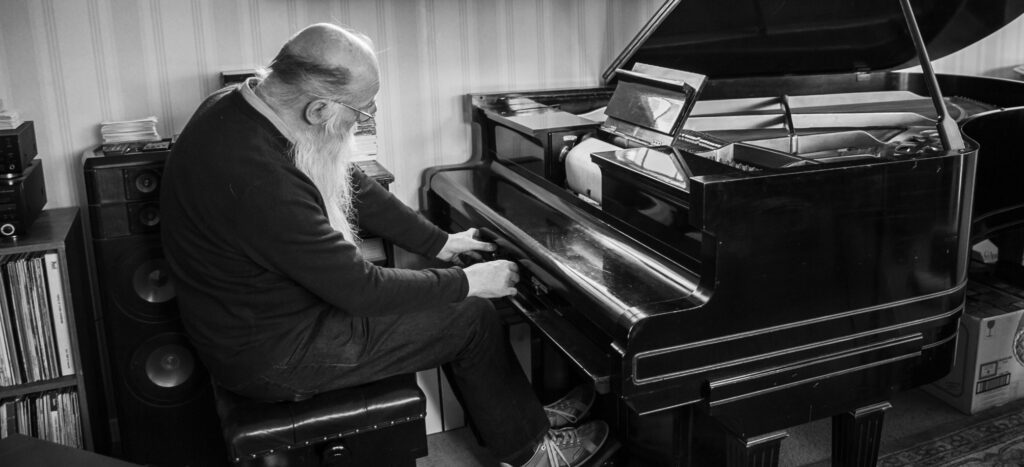
THE PIANO ROLLS
Institutions owning the piano rolls of this recording:
1- Mourant d’amour – Biblioteca de Catalunya
2- Sighing – Barcelona Music Museum
3- Vixen’s Dream – Barcelona Music Museum
4- Tigris – Biblioteca de Catalunya
5- Katherine – Biblioteca de Catalunya
6- Beloved – Mas Roger (Arxiu Comarcal)
7- Eros – Barcelona Music Museum
8- Nedym – Biblioteca de Catalunya
9- Fascinating – Mas Roger (Arxiu Comarcal)
10- Del Cheribón – Barcelona Music Museum
11- Mehlin – Barcelona Music Museum
12- Crying Fox – Mas Roger (Arxiu Comarcal)
13- The waltz of birds – Barcelona Music Museum
14- Victoria’s March – Barcelona Music Museum
15- The Canigó’s Mountains – Mas Roger (Arxiu Comarcal)

